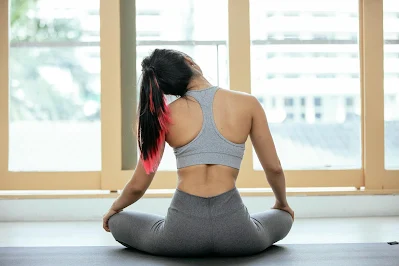Introduction
In today's fast-paced world, finding time for a workout can be challenging. However, with the right approach, you can fit effective exercise routines into even the busiest of schedules. This article will guide you through setting up your home workout space and provide quick routines tailored for those with hectic lives.
Benefits of Home Workouts
Home workouts offer numerous advantages, including convenience, flexibility, and cost-effectiveness. By exercising at home, you eliminate the need for commuting to the gym, saving both time and money. Additionally, you have the freedom to work out whenever it fits best into your day.
Setting Up Your Home Workout Space
Choosing the Right Location
Select a quiet and spacious area in your home where you can move freely without distractions. Ideally, choose a room with good ventilation and natural light to create a motivating workout environment.
Necessary Equipment
You don't need fancy gym equipment to have effective home workouts. Basic essentials include a yoga mat, resistance bands, dumbbells, and a stability ball. These versatile tools can help you target various muscle groups and achieve a full-body workout.
Quick Home Workout Routines
Morning Energizer Routine
Start your day with a quick energizing workout to boost your mood and metabolism. This routine may include dynamic stretches, bodyweight exercises like squats and lunges, and a brief cardio session to get your heart pumping.
Lunch Break Burner
Make the most of your lunch break by squeezing in a short but intense workout. Focus on high-intensity interval training (HIIT) exercises that elevate your heart rate and torch calories in a short amount of time. Circuit training, alternating between strength and cardio exercises, is also effective for maximizing results in minimal time.
Evening Relaxation Flow
Wind down from a busy day with a gentle evening workout focused on relaxation and flexibility. Incorporate yoga poses, deep breathing exercises, and foam rolling to release tension, improve mobility, and promote better sleep quality.
Incorporating HIIT Into Your Home Workouts
What is HIIT?
HIIT is a training technique that involves alternating between short bursts of intense exercise and brief periods of rest or low-intensity recovery. This approach is highly effective for burning fat, improving cardiovascular health, and increasing overall fitness levels.
Benefits of HIIT
One of the main advantages of HIIT is its efficiency. By pushing your body to its limits in short bursts, you can achieve significant results in less time compared to traditional steady-state cardio workouts. HIIT also stimulates the afterburn effect, causing your body to continue burning calories at an elevated rate even after you've finished exercising.
Sample HIIT Routine
Perform each exercise for 30 seconds, followed by 15 seconds of rest. Repeat the circuit 3-4 times. Jump Squats Push-Ups Mountain Climbers Burpees Plank Jacks
Staying Motivated and Consistent
Setting Realistic Goals
Set specific, measurable, and achievable fitness goals to keep yourself motivated and on track. Break down your larger goals into smaller, manageable milestones and celebrate your progress along the way.
Creating a Schedule
Schedule your workouts like any other important appointment, and stick to them as much as possible. Consistency is key to seeing results, so find a routine that works for you and make exercise a non-negotiable part of your day.
Finding Accountability Partners
Recruit friends, family members, or online communities to hold you accountable and provide support on your fitness journey. Having someone to share your successes and challenges with can help keep you motivated and accountable.
Nutrition Tips for Home Exercisers
Pre-Workout Fuel
Eat a balanced meal or snack containing carbohydrates and protein 1-2 hours before your workout to fuel your body and optimize performance. Examples include oatmeal with berries and Greek yogurt, a banana with almond butter, or a turkey and avocado wrap.
Post-Workout Recovery
Replenish your energy stores and support muscle recovery by consuming a combination of carbohydrates and protein within 30 minutes of finishing your workout. Options include a protein smoothie, chocolate milk, or a turkey and veggie stir-fry with quinoa.
Importance of Rest and Recovery
Rest and recovery are often overlooked aspects of fitness, but they are crucial for maximizing the benefits of your workouts and preventing burnout or injury. When you exercise, you're essentially breaking down muscle tissue, and it's during rest periods that your body repairs and rebuilds stronger muscle fibers.
Quality sleep is essential for optimal recovery, as it allows your body to produce growth hormone, repair damaged tissues, and regulate important metabolic processes. Aim for 7-9 hours of sleep per night to support your fitness goals and overall well-being.
Hydration is another key component of recovery, as water plays a vital role in nearly every bodily function, including nutrient transport, temperature regulation, and waste removal. Drink plenty of water throughout the day, especially before, during, and after your workouts, to stay hydrated and facilitate recovery.
In addition to sleep and hydration, stress management is also important for recovery. Chronic stress can increase inflammation in the body, hinder recovery processes, and negatively impact performance. Practice relaxation techniques such as deep breathing, meditation, or yoga to reduce stress levels and promote recovery.
Incorporating Variety Into Your Workouts
One of the challenges of working out at home is the potential for boredom or monotony, especially if you're limited in space or equipment. However, there are countless ways to add variety and keep your workouts fun and engaging.
Try incorporating different types of exercise modalities, such as strength training, cardio, flexibility, and balance exercises, to target different muscle groups and energy systems. Experiment with different workout formats, such as circuit training, interval training, or Tabata workouts, to keep your body guessing and prevent plateaus.
You can also change up your environment by taking your workouts outdoors or exploring new locations within your home. Whether it's a backyard boot camp, a park workout, or a living room dance party, mixing up your surroundings can invigorate your workouts and provide a refreshing change of scenery.
Don't be afraid to get creative with your exercises by using household items as makeshift gym equipment. For example, you can use a chair for tricep dips, a backpack filled with books for weighted squats, or a towel for slider exercises. The possibilities are endless when it comes to improvising with what you have available.
Overcoming Common Challenges
While home workouts offer numerous benefits, they also come with their own set of challenges. One common obstacle is finding the motivation to exercise consistently, especially when you're juggling multiple responsibilities or facing distractions at home.
To overcome this challenge, it's important to cultivate a positive mindset and focus on the reasons why you want to prioritize your health and fitness. Remind yourself of the benefits of exercise, such as increased energy, improved mood, and better overall health, and use these reasons as motivation to stay committed to your workouts.
Another common challenge is staying accountable without the structure and support of a gym or personal trainer. One strategy is to enlist the support of friends, family members, or online communities who share similar fitness goals. By forming an accountability group or workout buddy system, you can hold each other accountable, share progress updates, and provide encouragement and support along the way.
Additionally, setting realistic goals and tracking your progress can help you stay focused and motivated. Break down your larger goals into smaller, achievable milestones, and celebrate your successes along the way. Whether it's completing a certain number of workouts per week, increasing the intensity of your workouts, or achieving a specific fitness milestone, tracking your progress can help you stay motivated and on track towards your goals.
Conclusion
In conclusion, home workouts are a convenient and effective way to stay fit and healthy, even with a busy schedule. By setting up a dedicated workout space, incorporating quick and efficient routines, and prioritizing rest and recovery, you can achieve your fitness goals from the comfort of your own home. Remember to stay motivated, stay consistent, and most importantly, have fun with your workouts. With the right mindset and strategies, you can make home fitness a sustainable and enjoyable part of your lifestyle.
FAQs
Can I get an effective workout without any equipment?
Yes, bodyweight exercises can be highly effective for building strength and improving cardiovascular fitness. Incorporate moves like squats, lunges, push-ups, and planks into your routine for a challenging workout without any equipment.
How long should my home workouts be?
The duration of your workouts will depend on your fitness level, goals, and schedule. Aim for at least 30 minutes of moderate-intensity exercise most days of the week, but even shorter workouts can be beneficial if they're done with enough intensity and consistency.
What if I don't have much space at home for exercising?
You don't need a lot of space to get a good workout in. Clear a small area in your living room, bedroom, or even outdoors, and focus on exercises that don't require much room to move.
I struggle to stay motivated to exercise at home. Any tips?
Try varying your routine to keep things interesting and challenging. Set achievable goals, track your progress, and find ways to make your workouts enjoyable, whether it's by listening to music, watching workout videos, or exercising with a friend virtually.
How can I avoid injury while working out at home?
Pay attention to proper form and technique, especially when performing strength training exercises. Start gradually and listen to your body, avoiding any movements that cause pain or discomfort. Consider consulting with a fitness professional for personalized guidance and support.


